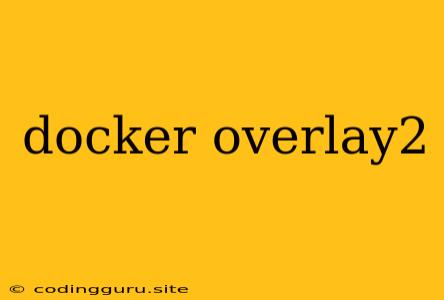Docker Overlay2: A Deep Dive into the Storage Driver
Docker, a powerful containerization platform, leverages storage drivers to manage the persistent storage for your containers. Overlay2 is one of the most popular and versatile storage drivers available for Docker. It offers a robust solution for handling container data, making it a cornerstone of many Docker deployments. But what exactly is Overlay2, and why is it so widely used?
What is Overlay2?
Overlay2 is a storage driver that uses a layered filesystem approach to manage container storage. It combines the simplicity of the AUFS (Another Union File System) driver with enhanced performance and scalability. Let's break down how it works:
- Layers: Docker images are constructed using layers, where each layer represents a specific change or addition to the image. Overlay2 stores these layers efficiently, allowing for sharing between containers and minimizing disk usage.
- Union Mount: When a container starts, Overlay2 creates a union mount. This virtualizes a combined filesystem by merging the layers of the base image and any subsequent changes made by the container. This allows for quick access to container data and facilitates efficient resource sharing.
- Writeable Layer: Overlay2 creates a writeable layer specifically for the container. All container modifications and data are stored within this layer, keeping the base image untouched and ensuring immutability.
- Data Locality: Overlay2 focuses on keeping the data within the same device. This is achieved by storing the writeable layer on the same device as the lower layers. This improves performance and reduces I/O overhead, especially for read-heavy operations.
Why Choose Overlay2?
Overlay2 offers a range of benefits that make it an ideal choice for Docker storage:
- Performance: Due to its layered structure and writeable layer optimization, Overlay2 provides fast access to container data, leading to faster container startup and application performance.
- Storage Efficiency: By utilizing layered filesystems and shared layers between containers, Overlay2 reduces the overall storage footprint, saving valuable disk space and improving efficiency.
- Scalability: Overlay2 is designed to handle large numbers of containers and their associated data, making it suitable for both small and large-scale deployments.
- Simplicity: Overlay2 provides a straightforward and user-friendly approach to managing container storage, making it easy to understand and configure.
How to Use Overlay2 with Docker
- Check the Default Driver: You can verify the current storage driver using the following command:
docker info | grep "Storage Driver"
- Switching to Overlay2: If the default driver is not Overlay2, you can switch to it by editing the Docker daemon configuration file (
/etc/docker/daemon.json) and adding:
{
"storage-driver": "overlay2"
}
- Restarting Docker: After making changes, restart the Docker daemon for the new configuration to take effect.
Troubleshooting Overlay2 Issues
- Space Constraints: Make sure your system has enough storage space for the Docker images, layers, and container data. Regularly check the disk usage and perform cleanup if necessary.
- Performance Bottlenecks: If you encounter performance issues, monitor I/O activity and investigate potential bottlenecks. Consider optimizing your system for Docker workloads or using dedicated storage devices.
- Compatibility: Overlay2 requires a kernel with the OverlayFS support. Ensure your kernel version meets the necessary requirements for proper functionality.
Conclusion
Overlay2 is a robust and efficient storage driver for Docker. Its layered approach, writeable layer optimizations, and data locality features make it a reliable choice for managing container storage. By understanding the concepts behind Overlay2, you can leverage its benefits to build and manage Docker containers effectively.
